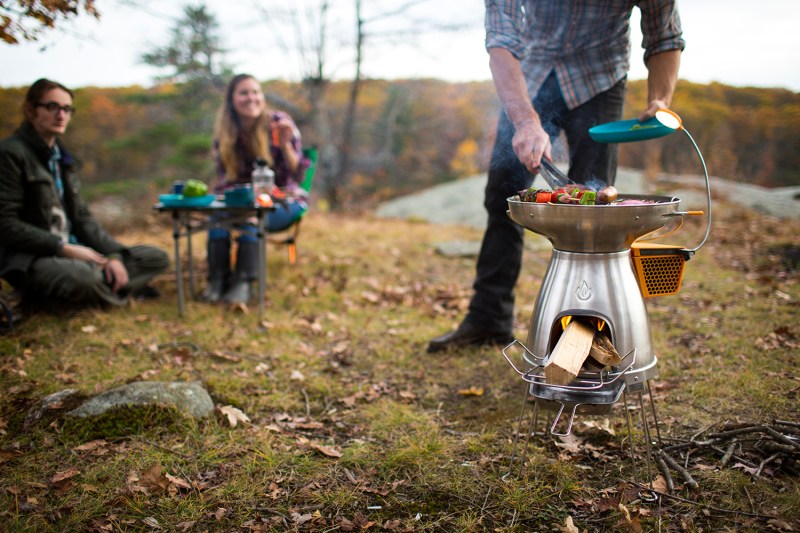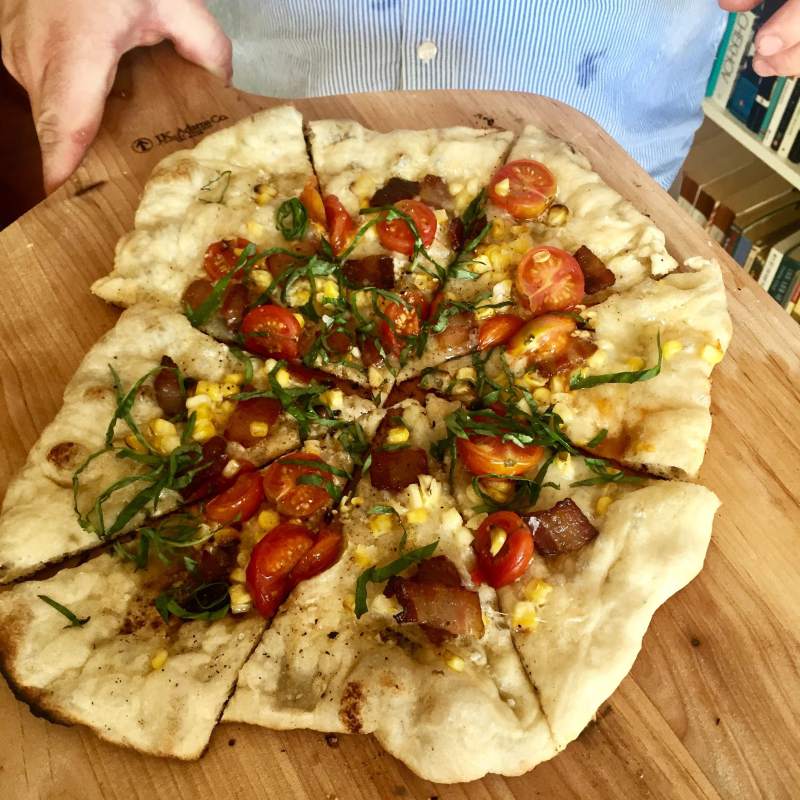Feasting is our column dedicated to cooking, grilling, eating and discovering what’s on the menu across America and the world.
Whether you’re an avid camper or simply love to grill but are dealing with a small space, BioLite has the answers to all of your cooking needs. And though we love all of their products, we’re especially psyched about one of their newest and coolest tools, the BaseCamp.
BioLite BaseCamp is so much more than a camping stove. It converts heat into usable electricity for large format cooking or charging. So as you’re burning branches and small pieces of firewood, the heat flows through a thermoelectric generator which powers a fan and sends surplus electricity to the USB charging port. Simply plug in your electronics to juice them up, or use the heat-generated electricity to power the included flexible USB light to illuminate a nighttime grill session. BaseCamp also features an internal fan that forces air back into the burn chamber which improves combustion to create a cleaner, more productive burn. An ashtray below the fuel rack catches debris to keep your campsite clean.

The BaseCamp is small and portable, equipped with a carrying handle and folding legs for adjustable cooking height. It’s also designed with a one-touch lever that instantly transforms the cooking surface to either concentrate or disperse the flame. We’ve used it to grill everything from veggie kabobs to sausages, but BaseCamp has an additional option that makes it stand out from the rest—a pizza stone. Aptly dubbed the PizzaDome, this attachment includes a triangular base to evenly distribute the flame, a domed lid and a ceramic pizza stone that will perfectly crisp up your favorite pies.
Cooking with the BaseCamp will do more than simply make your next meal perfect. Throughout many countries in India and sub-Saharan Africa, people die every day from smoke inhalation from cooking in their own homes. So a portion of every BioLite sale gets reinvested into the company’s initiatives to bring clean cooking and energy to thousands of families in developing nations.
Just for you, Manual readers, BioLite has lowered the price of the BaseCamp from $299.95 to $199.95 so you can save $100 on this incredible cooking tool. When you’re ready to fire up the grill, make your first meal this delicious pizza from Ted Rosen, the excellent chef behind all of the delicious food featured in this video.

Pizza with Roasted Corn, Market Tomatoes & Bacon
12-15” pizza dough
.5 cup Parmesan cream
.5 cup roasted corn
.5 cup fontina cheese (or any other tasty melting cheese), grated or cut into small cubes
.25 cup (or more) rendered guanciale
.5 cup cherry tomatoes, halved (or large ones cut into quarters)
.25 cut thin sliced red onion
The Dough:
This is an incredibly simple pizza dough that won’t take long to make and won’t leave you covered in flour. If you have a dough recipe you like, by all means, go for it. Don’t have time to make dough? Make friends with your local pizza shop and ask them for a round of dough. They should be more than willing to oblige.
Yield: 1 Large Pizza or 2 small pizzas
3 cups AP flour
One packet of instant yeast
1 cup lukewarm water
1 tbsp honey
In the bowl of a stand mixer with the dough hook attached, combine flour and yeast and mix for 10 seconds to roughly combine. Mix in water and honey and with the mixer on low speed, slowly pour the water into the bowl. Let the mixer work for 7 minutes then rest for 5 minutes. If the dough looks too dry at this point, add a tablespoon of water. If too wet, throw in a pinch of flour. Turn the mixer back on for another 5 minutes or until a smooth, tacky (but not sticky) ball forms. Transfer the ball of dough to a bowl greased with olive oil and let it proof for at least one hour at room temperature. If you’re going to make pizza right then, remove the ball of dough from the bowl and, on a well-floured work surface, begin rolling out the dough until the desired size is reached. If you’re making the pizza ahead of time, roll it into a tight ball and wrap with plastic. Store in the fridge until 1 hour before intended use.
The Bacon:
Really, any bacon will work in this recipe. I like using smoked pork jowl (aka smoked guanciale, aka face bacon) because of its sweet flavor and silky texture. Any good butcher worth their weight should carry something you can work with.
.5 pound smoked guanciale cut into .25-inch pieces
In a shallow pan, render the pork jowl on medium-low heat until it just begins to crisp. Don’t take it all the way to crispy as it will cook further on top of the pizza. Reserve any rendered fat for a rainy afternoon.
Parmesan Cream:
This is just as good of a pizza topping as it is a topical cream. Throw it in pasta sauces, garlic bread, use it as toothpaste—whatever floats your boat.
Yield: about 1 Quart
1 quart heavy cream
1 medium yellow onion, small dice
.5 cup Parmesan cheese rinds (if you can’t find rinds, use .25 cup shredded parmesan)
1 tbsp Olive Oil
In a small saucepan, sweat the onions in olive oil on medium-low heat for 5-7 minutes. Add the cream and Parmesan rinds and reduce to a simmer. Let the cream reduce for an additional 5 minutes. Turn off the heat and let the rinds steep for 10 minutes. Remove the rinds and pour the cream mixture into a heatproof container and store in the fridge.
Roasted Corn:
Because the corn is one of the main components of the pizza, getting good corn is important here.
6 ears sweet corn, shucked
2 tbsp olive oil (or better yet, use the rendered pork fat we made earlier!)
Salt and pepper to taste
Preheat your oven to 500 F or turn on your BioLite BaseCamp grill.
Rub the ears of corn with olive oil or bacon fat and season with salt and pepper. Roast or grill for 8 minutes or until the corn is nicely charred. If it’s not fully cooked, that’s ok. It’s going to cook again on the pizza.
Allow the corn to cool to a temperature that you’re comfortable handling and shave off the kernels into a bowl. Set aside until pizza time.
Let’s Make A Pizza!
Preheat your oven (ideally with a pizza stone) as hot as it will go. Better yet, fire up your Biolite Pizza Stone!
Roll your pizza dough out onto a well-floured pizza peel or an upside down sheet pan. Spread the Parmesan cream into an even, thin layer as you would tomato sauce. Place dots of fontina all around the pizza. Sprinkle the corn, bacon and tomatoes evenly and then top with thinly sliced red onion.
Carefully slide the pizza onto the stone or put the whole sheet pan in the oven and bake for 7-10 minutes or until the pizza is nice and bubbly.
Video by Max Schwartz


